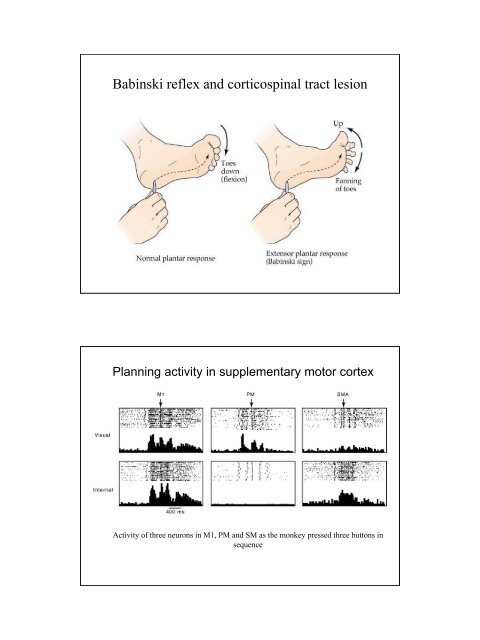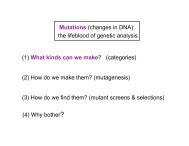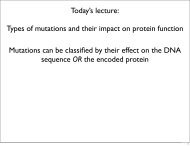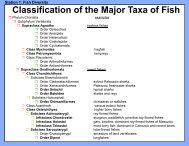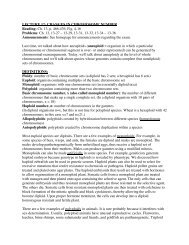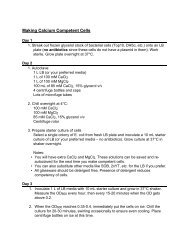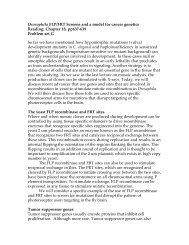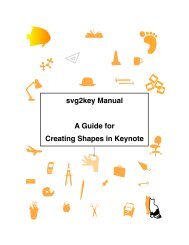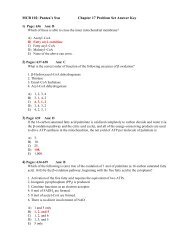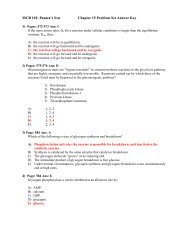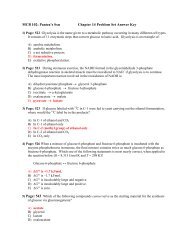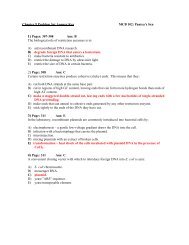Babinski reflex and corticospinal tract lesion
Babinski reflex and corticospinal tract lesion
Babinski reflex and corticospinal tract lesion
Create successful ePaper yourself
Turn your PDF publications into a flip-book with our unique Google optimized e-Paper software.
<strong>Babinski</strong> <strong>reflex</strong> <strong>and</strong> <strong>corticospinal</strong> <strong>tract</strong> <strong>lesion</strong>Planning activity in supplementary motor cortexActivity of three neurons in M1, PM <strong>and</strong> SM as the monkey pressed three buttons insequence
Spinal ReflexesLu Chen, Ph.D.MCB, UC Berkeley1Simple <strong>reflex</strong>es such as stretch <strong>reflex</strong> require coordinatedcon<strong>tract</strong>ion <strong>and</strong> relaxation of different muscle groupsCategories of Muscle Based on Direction of MotionFlexors reduce the angle of jointsExtensors increase the angle of jointsCategories of Muscle Based on MovementAgonist muscle that serves to move thejoint in the same direction as the studiedmuscleAntagonist muscle that moves the jointin the opposite direction2
Muscle SpindlesIntrafusal musclefiberscapsuleSensoryendingsAfferent axonsEfferent axonsGamma motorendings•Small encapsulated sensory receptors that have aspindle-like shape <strong>and</strong> are located within thefleshy part of the muscle•In parallel with the muscle fibers•Does not contribute to the overall con<strong>tract</strong>ileforce•Mechanoreceptors are activated by stretch of thecentral region•Due to stretch of the whole muscle(including intrafusal f.)•Due to con<strong>tract</strong>ion of the polar regions ofthe intrafusal fibers3Muscle SpindlesOrganization2 kinds of intrafusal muscle fibers•Nuclear bag fibers (2-3)•Dynamic•Static•Nuclear chain fibers (~5)•Static2 types of sensory fibers•Ia (primary) - central region of allintrafusal fibers•II (secondary) - adjacent to the centralregion of static nuclear bag fibers <strong>and</strong>nuclear chain fibersIntrafusal fibers stretched(loading the spindle)Sensory ending stretched,increase firingMuscle fibers lengthens(stretched)Sensory ending stretched,increase firingMuscle fiber shortensSpindle unloaded,decrease firing4
Muscle SpindlesOrganizationGamma motor neurons innervate the intrafusal muscle fibers.Activation ofgamma neuronsShortening of the polar regionsof the intrafusal fibersStretches the noncon<strong>tract</strong>ilecenter regionsIncrease firing of thesensory endingsTherefore, the gamma motor neurons provide amechanism for adjusting the sensitivity of the musclespindles.2 types of motor fibers•Static gamma motor neuron – innervate both staticbag <strong>and</strong> chain fibers•Dynamic gamma motor neuron – innervate onlydynamic bag fibers5Gamma motor neurons: Static <strong>and</strong> Dynamic ResponsesIa sensory fiber responseStretch alone: small dynamic response to musclestretch, a moderate increase in steady-state firing.Static gamma motor neuron stimulated: steady-stateresponse increase, dynamic response decrease.Dynamic gamma motor neuron stimulated: dynamicresponse markedly enhanced, steady-state responsegradually returns to original level.Increase in activity of dynamic gamma motor neuronsincrease the dynamic sensitivity of the type Ia endingsbut have no influence on the type II endings.Increase in activity of static gamma motor neuronsincrease the tonic level of activity in both the type Ia <strong>and</strong>II endings, decrease the dynamic sensitivity of type Iaendings.6
Activation of gamma MN during active muscle con<strong>tract</strong>ion enablesthe muscle spindles to continue sensing changes in muscle length•Activation of the gamma motorneurons leads to con<strong>tract</strong>ion of theends of the fibers, which stretch ofthe central regions.•This allows the spindle to respond tochanges in muscle length over a widevariety of lengths. I.e. adjusts thespindle sensitivity•The activation of alpha <strong>and</strong> gammamotor neurons together enable themuscle spindle to respond duringlong con<strong>tract</strong>ions.•Alpha <strong>and</strong> gamma MN are activatedtogether during voluntarymovements.(alpha-gammacoactivation)7The Alpha-Gamma Co-activationDescendingPathwaysIncrease in gammaMN firingIncrease in IafiringIncrease in alphaMN firingIncreased MuscleCon<strong>tract</strong>ion8
Golgi Tendon Organ•Located at the junction between muscle fibers <strong>and</strong> tendon•Connected in series with the skeletal muscle fibers•Tendon Organs are most sensitive to muscle tension•Innervated by a single Ib axon, which demyelinates whenentering the capsule. There is branches into many small endingswhich intertwine with the collagen fibers.•Stretching of the tendon organ (when the muscle con<strong>tract</strong>s)straightens the collagen fibers, compressing the Ib branches <strong>and</strong>causing the cell to fire•The average level of activity in a population of tendon organsin a muscle gives a good idea of the force done by the muscleMuscle spindles: sensitive to changes in muscle length.Golgi tendon organs: sensitive to changes in muscle tension.9Muscle Spindle vs Golgi Tendon Organ10
Summary of Sensory FibersIa•Goes from the chain <strong>and</strong> bag nuclear fibers (static <strong>and</strong> dynamic) of themuscle spindle to the spinal cord.•Sensitive to muscle length <strong>and</strong> rate of change of lengthII• Goes from the chain <strong>and</strong> bag nuclear fibers (static) of the muscle spindle tothe spinal cord.•Sensitive to muscle lengthIb•Goes from the Golgi Tendon Organs to the spinal cord.•Sensitive to muscle tensionAnd others that respond to painful stimuli, temperature, etc11Stretch Reflex12
Stretch ReflexAgonist muscleAntagonistmuscle+-+MonosynapticServes to maintain the muscle toneFeedback system keeping the muscles around a set lengthIt involves a con<strong>tract</strong>ion that takes place when the muscle gets stretched.Mechanism: When the muscle is stretched, this results in the stretching of the intrafusal muscle fibersin the muscle spindle. As a result, the Ia endings are stretched <strong>and</strong> increase their firing rate. They makeexcitatory connections onto the alpha MN innervating the same muscle <strong>and</strong> also onto those innervatingsynergistic muscles. Thus, the muscle con<strong>tract</strong>s <strong>and</strong> its length is reduced.Ia fibers can also synapse onto inhibitory interneurons <strong>and</strong> cause the relaxation of the antagonistmuscles. (polysynaptic component)13Flexion Withdrawal ReflexPolysynaptic--Protective ReflexThe limb is quickly withdrawn froma painful stimulus,usually by thesimultaneous con<strong>tract</strong>ion of allflexor muscles in the limbExtensormusclepainFlexormuscleMechanism: When there is a painful stimulus, the sensorysignal excites the motor neurons that innervate flexormuscles of the stimulated limb <strong>and</strong> inhibits MN thatinnervate the extensor muscles of the limb (reciprocalinnervation)Also, the <strong>reflex</strong> can produce an opposite effect in thecontralateral limb to enhance postural support. (crossextension<strong>reflex</strong>)FlexormuscleExtensormuscle14
Functions of the Ia inhibitory interneuronsThe Ia interneuron allows higher centers tocoordinate opposing muscles at ajoint through a single comm<strong>and</strong>.1) Mediates reciprocal innervation instretch <strong>reflex</strong> circuits.2) Receives input from corticaldescending pathway. A singledescending signal that activates oneset of muscles automatically leads torelaxation of the antagonists.3) Other descending pathway providesexcitatory or inhibitory connectionsto Ia neurons (I.e. greater inhibitionallowing con<strong>tract</strong>ion of opposingmuscles to occur).15Functions of the Renshaw Cells• inhibitory interneuron• Inputs: Excited by collaterals of the axons ofmotor neurons (leads to presynaptic inhibition);descending pathways•Effects:•Inhibition of large transient movements•Dis-inhibition of the antagonist muscle•Central modulation regulates the sensitivity ofMN to afferent input16


